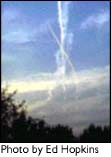Monthly News Summary – June 1997
In the News: June 1997
A record of SSEC media appearances compiled for June 1997. Direct comments, questions, and information about other SSEC references to Terri Gregory, SSEC’s Public Information Specialist.
Contrails May Affect Weather
For More Information
Jet pollution may increase cloud cover in areas with heavy air traffic by as much as 20%, conclude Steven Ackerman and other SSEC scientists. They’ve studied contrails, or jet exhaust plumes, for the past year and are concerned about their possible affect on the Earth’s weather. That concern stems in part because contrails can, like all clouds, reflect the sun’s radiation back into space or trap infrared radiation emitted from the Earth’s surface. Scientists won’t know how contrails work until they know what size particles they’re made of, whether they can become high cirrus clouds, how much they spread out, and how long they linger–all questions which are not easily answered.
Ron Seely, a Wisconsin State Journal science reporter, explained how SSEC scientists use four different planes to study the pretty, but menacing, phenomena. “One lays down a contrail, the second tailgates and samples the contrail at close range, the third observes from an intermediate distance, and the fourth high-flying aircraft looks down on the contrail much as a satellite would.”
Ackerman’s future studies will focus on the size of ice crystals in contrails. In the June 1 State Journal article, Ackerman explains: “The smaller the ice crystals, the more efficient the reflector. They may not only be modifying energy balance, but how energy is distributed.” Seely asks readers to consider that “more than 62 million commercial and military flights leave these featherlike trails of exhaust in the sky every year.”
Terry Devitt, UW News, reported from May’s meeting of the American Geophysical Union that, in addition to SSEC research, NASA’s Earth Observing System will also help answer contrail questions. The first EOS satellite is to be launched in summer 1998.
Both the Milwaukee Journal-Sentinel and Earth Watch Radio also covered this contrail story. Earth Watch is syndicated in the United States and Canada. If you hear the story on your local radio station, drop us an email using our online form.
SSEC in Print
For More Information
The World Climate Research Programme uses SSEC’s global montage on the cover of its booklet advertising this summer’s conference. The cover image keeps the oval shape of the montage but slices it up with two other composites, one from the World Ocean Circulation Experiment and another, unidentified, image. The clever juxtaposition of pieces makes for a most pleasing image.
The Conference on the World Climate Research Programme takes place in Geneva, Switzerland, August 26-28, 1997. Sponsors hope to give scientists, policy makers and technical experts the chance to review the program’s accomplishments from its first 17 years and to help plan WCRP’s next 10 to 15 years.
Madison’s spring weather seemed much windier than usual, and Capital Times reporter Karyn Saemann interviewed experts to find out why. One of them was SSEC scientist Dave Martin, who explained that “southern Wisconsin has been on the south side of a string of low pressure systems” that tracked across the upper midwest. Strong winds often blow on the south or west of such storms. The story ran May 27, 1997, just before the weather changed to a more seasonable calm.
Using the Internet, Steve Ackerman’s students will be able to “interpret weather maps and learn the concept of atmospheric stability.” The May 14 issue of Wisconsin Week, UW-Madison’s campus newspaper, reported on the award of instructional technology grants. One of the six recipients (out of thirty proposals) was SSEC scientist Professor Ackerman, who will develop interactive learning activities for his introductory courses in the Department of Atmospheric and Oceanic Sciences.
SSEC on the ‘Net
For More Information
Todd Sikora, a new assistant professor in the U.S. Naval Academy’s Department of Oceanography is so impressed with the WxWise Web page prepared by Steve Ackerman and colleagues that he’s asked to use some of the modules in his courses. He said he is particularly impressed with the link to S.S. Edmund Fitzgerald material.
Tyler Volk, an associate professor of biology at NYU, is completing a book called Gaia’s Body: Toward a Physiology of the Earth, in which he will use GOES-8 and -9 images from the SSEC Real-time Data Web page. Volk plans to show a series of “glorious cloud patterns” so that readers can visualize atmospheric changes over four days. The book is to be published by Copernicus Books in the fall.
Rice University is collaborating with NASA and the Houston Museum of Natural Science on a CD called Earth Views of Space and Space Views of Earth. According to Patricia Rieff, Chairperson of the Department of Space Physics and Astronomy, it will include the best images that can be found on the Web, including ours. The South Florida Water Management District will use an SSEC infrared image of Earth on a report cover. Engineer Paul Trimble says of the image from our Web site, “It’s a really nice view.”
Teaching and Outreach
For More Information
WISC-TV’s Linda Eggert covered the Red Rover project June 19, the second-to-last day of the program. During the two-week project, middle school students built and tested models of the NASA robot explorer that landed on Mars July 4. Using interviews with the kids and plenty of on-the-spot video, Eggert did a good job of showing the project to be both fun and educational.
A Web article by University News Web creator Nick Weaver prominently features pictures of rovers and terrain designed and built by middle school students at Lincoln School.
Sanjay Limaye and Rosalyn Pertzborn of SSEC, teacher David Wirth, and Jennifer Topinka, who is enrolled in UW-Madison’s School of Education, were all instructors for the program. Red Rover, part of the College Access Program, involved students from schools in Madison and Brookfield and took place at Madison’s Lincoln School.

